
Image Source: http://upload.wikimedia.org
Hot air Balloons expand out to full size by filling them up with heated air.
In this lesson we are doing a different type of expanding out; one which involves two or more terms inside brackets that are raised to a power.
For two or more items inside brackets, that are then raised to a Power, we use the “Expanding Exponent Products Rule”.
This rule is kind of like a beefed up version of the Power of Power Rule.
At Passy’s World, we like to think of it as the Big Brother of the Power of Power Rule.
The Power of Power rule is used for when there is only one base item in the brackets, and works like this.
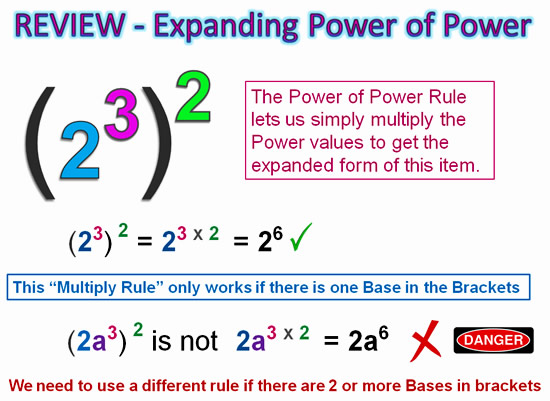
Image Copyright 2013 by Passy’s World of Mathematics
Expanding Exponent Products Rule
In the following example we look at a two items in the brackets expansion, the “long way”, and then work it out using the Expanding Products Rule.
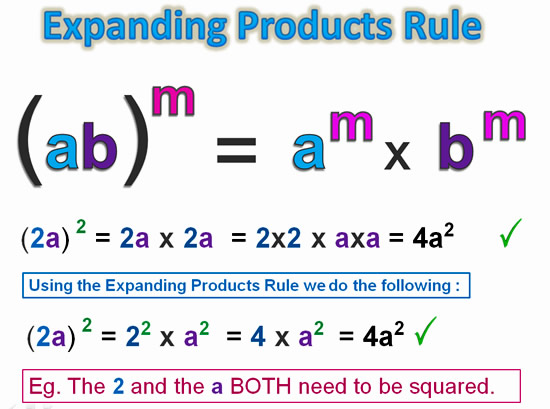
Image Copyright 2013 by Passy’s World of Mathematics
Basically the Products Rule is as follows:
The Power outside the brackets needs to be applied to all Bases Inside the brackets.
Unlike other exponent rules, it is quite okay for these two bases to be different.
It is a lot like the Distributive Law, but is for Exponents.
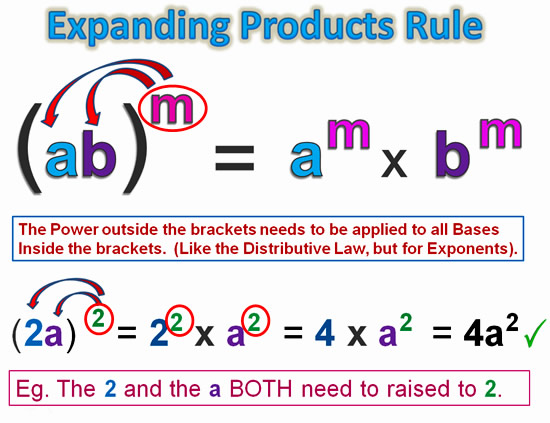
Image Copyright 2013 by Passy’s World of Mathematics
It is important not to confuse the Products Rule with the Power of Power Rule.
The Products Rule applies when we have more than one Base Item in the brackets.
If there is only one Base item in the brackets, we use the Power of Power Rule.
The Exponents Products Rule can look a lot like the Power of Power Rule, but always has two or more items in the brackets.
It is kind of like the Power of Power Rule’s Big Brother, as shown in the following example.

Image Copyright 2013 by Passy’s World of Mathematics
Videos About the Exponent Products Rule
The following video shows the pattern whcih creates the Products Rule, and then does several examples.
The following video reviews the normal multiplication add rule, then covers Power of Power, and then at 4 minutes 28 seconds into the video, the Products Rule is demonstrated.
The following video also reviews the normal multiplication add rule, then covers Power of Power, and then around 5 minutes into the video, the Products Rule is demonstrated.
The following video shows how we can derive the Products Rule.
Expanding Exponent Products Rule – Examples
The following examples show how to apply the Expanding Exponents Product Rule when we have two or more base items in brackets raised to a power.
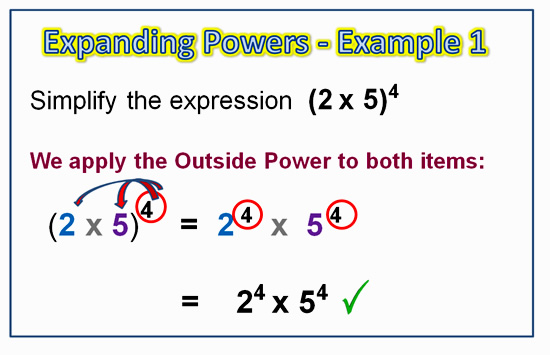
Image Copyright 2013 by Passy’s World of Mathematics
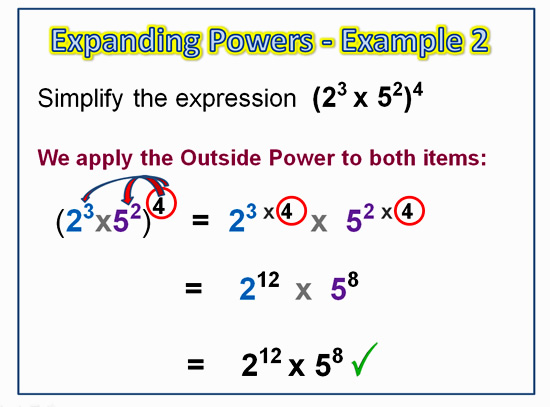
Image Copyright 2013 by Passy’s World of Mathematics

Image Copyright 2013 by Passy’s World of Mathematics
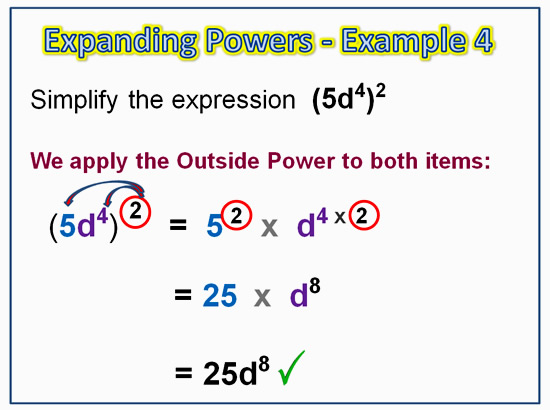
Image Copyright 2013 by Passy’s World of Mathematics
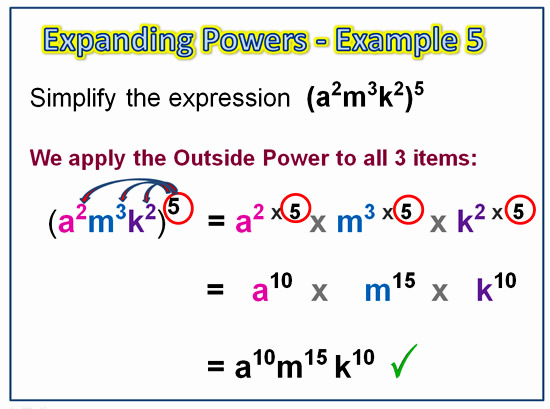
Image Copyright 2013 by Passy’s World of Mathematics
Product Rule Backwards for Simplifying
We can use the reverse of the product rule to combine two different bases, THAT ARE BOTH TO THE SAME POWER, into a single bracketed item.
The two different bases can be: two numbers, a number and a letter, or two letters; however it is required that both items are raised to the exact same Power.
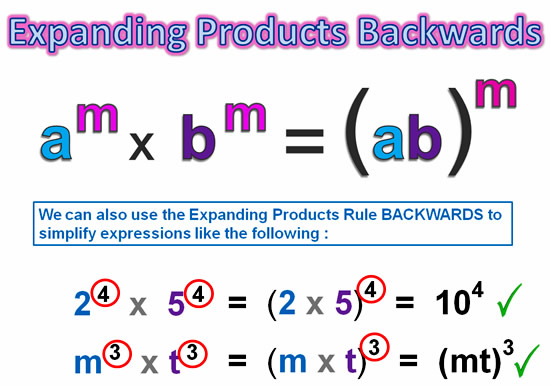
Image Copyright 2013 by Passy’s World of Mathematics
Product Rule Backwards – EXAMPLES
We can use the reverse of the product rule to combine two different bases, THAT ARE BOTH TO THE SAME POWER, into a single bracketed item.
The two different bases can be: two numbers, a number and a letter, or two letters.
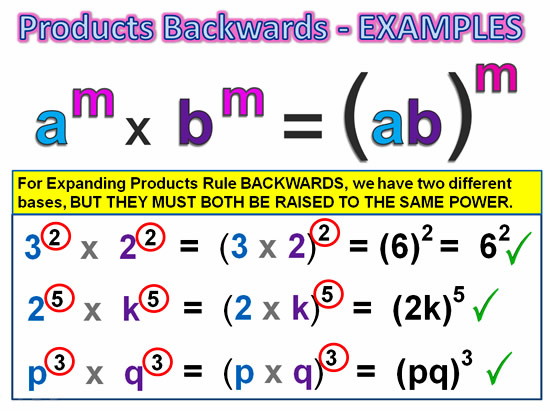
Image Copyright 2013 by Passy’s World of Mathematics
Exponent of Products Rule – SUMMARY
The following diagram summarises the forwards and backwards use of the Expanding Products Rule.
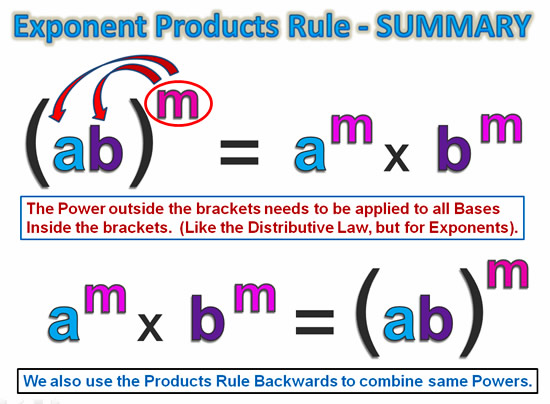
Image Copyright 2013 by Passy’s World of Mathematics
Related Items
Basic Indices and Exponents
Multiplying Exponents
Dividing Algebra Expressions
Dividing Exponents Using Subtraction Rule
Power of Power Exponents Rule
Subscribe
If you enjoyed this lesson, why not get a free subscription to our website.
You can then receive notifications of new pages directly to your email address.
Go to the subscribe area on the right hand sidebar, fill in your email address and then click the “Subscribe” button.
To find out exactly how free subscription works, click the following link:
If you would like to submit an idea for an article, or be a guest writer on our website, then please email us at the hotmail address shown in the right hand side bar of this page.
If you are a subscriber to Passy’s World of Mathematics, and would like to receive a free PowerPoint version of this lesson, that is 100% free to you as a Subscriber, then email us at the following address:
Please state in your email that you wish to obtain the free subscriber copy of the “Expanding Exponent Products” Powerpoint.
Help Passy’s World Grow
Each day Passy’s World provides hundreds of people with mathematics lessons free of charge.
Help us to maintain this free service and keep it growing.
Donate any amount from $2 upwards through PayPal by clicking the PayPal image below. Thank you!
PayPal does accept Credit Cards, but you will have to supply an email address and password so that PayPal can create a PayPal account for you to process the transaction through. There will be no processing fee charged to you by this action, as PayPal deducts a fee from your donation before it reaches Passy’s World.
Enjoy,
Passy





Pingback: Expanding Exponent Quotients | Passy's World of Mathematics
Pingback: Exponents in the Real World | Passy's World of Mathematics
Pingback: Zero and Negative Exponents | Passy's World of Mathematics
Pingback: Scientific Notation | Passy's World of Mathematics